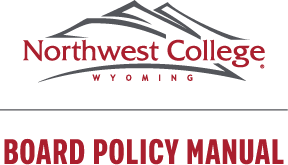To print please use PDF download.
- The Board of Trustees is committed to providing a safe environment for students, employees, and the greater campus community. The purpose of this policy is to promote an educational environment by regulating the possession, use, and storage of firearms and other weapons on all properties owned, leased, and/or controlled by the College.
- The Board of Trustees prohibits the possession, use or storage of firearms and any other dangerous weapons on campus or at any college-sponsored event, unless that individual has been issued and possesses a valid concealed carry permit, or is a certified peace officer; pursuant to W.S. [6-8-104(a)(i) and (ii)].
- The Board of Trustees directs and authorizes the President to develop procedures regarding the implementation of this Policy.
Procedures
- Definitions
- College Property - for purposes of this procedure, means any physical property owned, leased, and/or controlled by the college. College property does not include property that is leased
to another entity. - Concealed carry - means carrying a firearm so that the firearm is not discernible by ordinary observation and is located on or about the person or is within arm's reach of the person and is readily
accessible for prompt use. - Concealed Carry Permit - means a permit that has been issued pursuant to W.S. [6-8-104(y)(ii)].
- Firearm - any pistol, revolver, or derringer, designed to be fired by the use of a single hand. W.S. [6-8-104(y)(ii)].
- On or about the person - means in such close proximity to the person that it is readily accessible for prompt use. A permittee may carry a holstered firearm in a backpack or handbag, but it must be close enough that the permittee can grasp it without materially changing position.
- Open carry - means carrying a firearm or dangerous weapon visible to others.
- Permittees - those individuals who have been issued a valid concealed carry permit pursuant to W.S. [6-8-104(a)(i) and (ii)].
-
- Any object or device which will, is designed to, or may be readily converted to expel a bullet, shot, or shell by the action of an explosive or other propellant
- Any handgun, pistol, revolver, rifle, shotgun, or other firearm of any nature, including those that are concealed or openly carried.
- Any martial arts weapon such as nunchucks or throwing stars.
- Any longbow, crossbow, arrows, or other projectile that could cause serious harm to any person.
- Any incendiary of explosive material, liquid, solid or mixture equipped with a fuse, wick or other detonating device.
- Any tear gas or smoke bomb; however, personal self-defense items containing mace or pepper shall not be deemed a weapon under this policy.
- Any knife, commonly referred to as a switchblade, which has a blade that opens automatically by hand pressure applied to a button, spring or other device in the handle, or any knife having a blade that opens or falls or is ejected into position by the force of gravity.
- Any straight-blade knife with a four-inch blade length or more. An ordinary pocketknife or culinary knife designed for and used solely in the preparation of service of food shall not be construed as a weapon for the purposes of this policy.
- Any other dangerous or deadly weapon or instrument of like character.
-
- College Property - for purposes of this procedure, means any physical property owned, leased, and/or controlled by the college. College property does not include property that is leased
- Responsibilities
- Permittees are personally responsible for any injury or damage resulting from the use or possession of their firearm.
- Permittees must have their concealed carry permit along with valid identification on their persons when they are concealed carrying a firearm.
- Permittees may not open carry a partially or wholly visible firearm on campus property.
- Permittees who carry a firearm on campus must always carry it concealed and on or about their person or is in such close proximity to the person that it is readily accessible for prompt use.
- While on campus property, permittees are required to keep the firearm in a holster that completely covers the trigger and entire trigger guard area. The holster must have sufficient tension or grip on the handgun to retain it in the holster even when subjected to unexpected jostling.
- Firearms with an external safety must be carried with the safety in the 'on' position.
- Firearm Storage
- Permittees who cannot keep their firearm on or about their person must secure their firearm(s) as follows:
- In a concealed biometric container, or
- In a lock box that has a high-strength locking system consisting of a mechanical or electronic combination and not a key lock.
- Any container/lock box must be large enough to fully contain all firearms placed in it and provide secure storage.
- Permittees may not secure their firearm(s) in a locked, privately-owned, or leased motor vehicle, unless it is secured as identified above.
- The College shall not require the storage of firearms separate from ammunition as required by W.S. [6-8-105(d)(vii)(B).
- Permittees who cannot keep their firearm on or about their person must secure their firearm(s) as follows:
- College Property
- Permittees are allowed to have their firearms in any location on college property, including but not limited to, outdoor areas, as well as buildings and spaces that are accessible to the public, unless in a prohibited area.
- Permittees are allowed to conceal carry in individual or private offices, departmental spaces, and classrooms. College employees may not impose a ban on firearms by permittees in departments, classrooms, or offices.
- Exclusion Areas
The following areas are prohibited for firearms and other deadly weapons, including for permittees:- College athletic events where alcohol is being sold/tendered.
- College property where explosive or volatile materials are present, in such an amount that may reasonably cause serious bodily injury due to the materials' explosive or volatile nature.
- Some locations on college property include, but are not limited to:
- Engineering Shops and Workshops
- Welding classes
- Chemistry Laboratories
- Chemical Storage Rooms
- Firearms Training Laboratories
- Aeronautical training spaces subject to FAA regulations
- Engineering Shops and Workshops
- College property containing explosive or volatile materials may be marked with a conspicuous sign indicating firearms are prohibited. It is the responsibility of the permittee to know these locations.
- Some locations on college property include, but are not limited to:
- Any place where the carrying of firearms is prohibited by federal law or regulation or state law.

